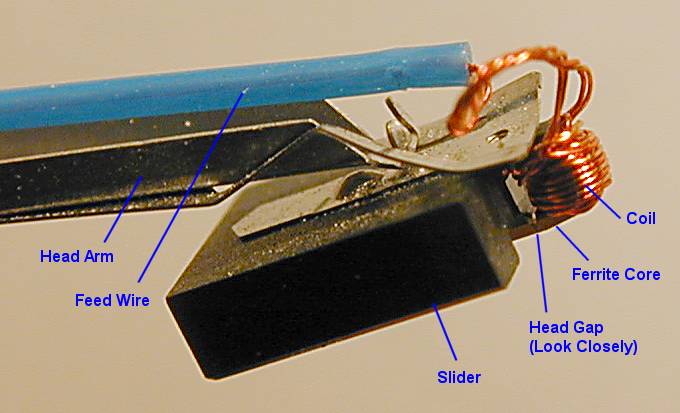[ The PC Guide | Systems and Components Reference Guide | Hard Disk Drives | Construction and Operation of the Hard Disk | Hard Disk Read/Write Heads | Hard Disk Read/Write Head Technologies ]
Ferrite Heads
The oldest head design is also the simplest conceptually. A ferrite head is a U-shaped iron core wrapped with electrical windings to create the read/write head--almost a classical electromagnet, but very small. (The name "ferrite" comes from the iron of the core.) The result of this design is much like a child's U-shaped magnet, with each end representing one of the poles, north and south. When writing, the current in the coil creates a polarized magnetic field in the gap between the poles of the core, which magnetizes the surface of the platter where the head is located. When the direction of the current is reversed, the opposite polarity magnetic field is created. For reading, the process is reversed: the head is passed over the magnetic fields and a current of one direction or another is induced in the windings, depending on the polarity of the magnetic field. See here for more general details on how the read/write heads work.
|
Extreme closeup view of a ferrite read/write head from
a mid-1980s Seagate ST-251, one of |
Ferrite heads suffer from being large and cumbersome, which means they must ride at a relatively great distance from the platter and must have reasonably large and strong magnetic fields. Their design prevents their use with modern, very-high-density hard disk media, and they are now obsolete and no longer used. They are typically encountered in PC hard disks under 50 MB in size.
![]() Next: Metal-In-Gap (MIG) Heads
Next: Metal-In-Gap (MIG) Heads
| The PC Guide
(http://www.PCGuide.com) Site Version: 2.2.0 - Version Date: April 17, 2001 © Copyright 1997-2004 Charles M. Kozierok. All Rights Reserved. |
Not responsible for any loss resulting from the use of this site. Please read the Site Guide before using this material. |
